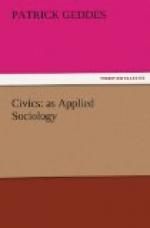L—THE CITY COMPLIED: TOWN, SCHOOL, CLOISTER, AND CITY PROPER
In course of this fourfold analysis, it is plain that we have reached the very converse—or at all events the [Page: 90] complement—of that geographical determinism with which we started, and that we have returned to a view corresponding to the popular one (of “People, Affairs, Places,” p. 69), which we then set aside for the reasons given. The “great man theory” of history, at best less crudely stated, thus reappears; in short, to the initial thesis we have now the distinct antithesis. It is time, therefore, to bring these together towards the needed synthesis. Hence to the page (p. 77) on which was summarised the determinist view of Town and School, we now require the complemental statement upon page (p. 87) of Cloister and City proper. Nor must we be content, with too many controversialists hitherto, to keep in view only one at a time; but by folding back the pages of print between these two half-schemes, as the book lies open, to take in both together.
We may thus finally compress the essentials of this whole paper into a simple formula—
TOWN | CITY | FOLK | POLITY | WORK | CULTURE | | ^ PLACE | | | ART -----------------|----|----|---------------------- LORE | | | IMAGERY v | | LEAR | IDEA | LOVE | IDEAL | SCHOOL | CLOISTER
or most briefly—
| TOWN | CITY ^ | -------+--------- | v SCHOOL | CLOISTER |
[Page: 91]—noting in every case the opposite direction of the arrows. The application of this formula to different types of town, such as those already indicated in the former instalment of this paper (Vol. I., p. 107) or in the present one, will not be found to present any insuperable difficulty. It must, however, be kept clearly in view that the city of each day and generation subsides or decays more or less completely into the mere town anew, as the cloister into the schools. The towns and cities of the world are thus classifiable in terms of their past development and present condition.
Summary
Condensing now this lengthy, yet compressed and abbreviated series of analyses into a single page of summary, we may briefly define the main aspects and departments of civics from the present point of view. First then, comes the study of civics as fundamentally (and ever anew) an orderly development—at once geographic, economic, and anthropologic in its nature—a survey of place, work, and folk—and these not merely or mainly as broken up into the fine dust of censuses and statistics, nor even of the three too separate sciences above named, but as a living unity, the human hive, the Town.




